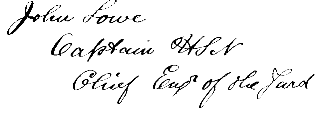US Navy Yard League Island
August 7 1899
Sir
Referring to the Department order 180609 July 7 1899. I beg leave to report, that on July 24, 1899 in New York City, I witnessed a very costly experiment made by the Holland Torpedo Boat Company, which I consider of value sufficient to communicate to the Department for its information.
Among other things, it illustrates the great care bestowed upon every step taken by this Company.
In their Torpedo Boats, it will be remembered, that it is the intention to maintain a pressure of only one atmosphere in the living spaces, no matter how little or much that the boat may be submerged.
Consequently, the hull must be strong enough to resist the collapsing pressure, due to the greatest depth, to which by any reasonable possibility it may be submerged subjected, and it is the object of this experiment, to obtain precise information upon this point.
The blue prints submitted show a portion of the hull # 8 designed by this company, & of slightly lighter construction than the Holland, to a scale 3/8 full size, every part of the model being on this scale & the frames welded at the butted ends.
This Hull is contained within an outer vessel, by means of which an hydraulic pressure can be applied, tending to collapse the hull, the inside of the hull being at all times open for inspection, & the length of the model being sufficient to receive no stiffening from the end supports.
A hatch is provided in the cover, to test the strength of each opening, in conjunction with the necessary stiffening plates, all of which are shown in the blue prints & photographs submitted herewith.
Upon this occassion such a pressure was gradually applied until a leak developed was produced, by cutting of rubber gasket at the hatch cover joint, when the experiment was stopped, at a pressure of 110 pounds equivalent to a depth of 253 feet below the surface, a depth no torpedo boat will ever be called upon to reach.
At this pressure, the Hull showed no signs of distress so therefore after this leak is closed, the company will proceed to a further test in search of further confirmation, until the final collapse of the structure.
Subsequently pressures of 110 lbs, 120 lbs, and 150 pounds, were applied without causing distress, the photographs enclosed, illustrating this.
There are many who will contend, that this one experiment is good enough only so far as it goes & will assert, that much and varied experiment must be made before it can be applied to a tube either greater or smaller than itself.
The problem is a new one, & of such exceeding interest, that I ask pardon for dwelling upon it, while I demonstrated to the contrary as follows:
Contemplate an athwartship element of the model. It is a circular girder loaded uniformly, with (c) pounds per surface unit; but able to withstand (k) pounds without deformation.
Adopting the methods of the Calculus, contemplate a second girder, the ... dimensions of which are, length = dl, bredth = db, depth (dr).
Its strength will be ds =
k(db)(dr)
2 (1)
dl
Its load will be
dw = c(db)(dl)
(2)
Comparing these DV = ds =
k(db)(dr)
2
(3)
dw c(db)(dl)2
Now then increase the dimensions of this girder, until they become those of girder of the model
then v = kr2
cl2
Now then again increase this girder n times, until it becomes the full sized girder of the boat
then V = k n 2r 2
c nl2
nkr 2
Compare these, then V = c l2 = n
v k r 2
c l2
The full sized boat is therefore n times as strong as the model, where n is the scale and the experiment does not need repetition but is complete & rigidly conclusive
Very Respectfully

The Honorable Secretary of the Navy
See next page
